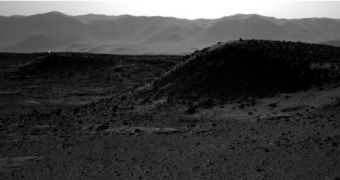Mission controllers with the NASA Jet Propulsion Laboratory (JPL) in Pasadena, California announce that the Mars Science Laboratory (MSL) rover Curiosity has snapped a peculiar image on the surface of the Red Planet, at a location called Kimberley. The image features a bright spot whose origins are still debated, the group says. The photograph was collected on April 2, with a follow-up one on April 3.
The view above is the one collected on April 3, shortly after Curiosity completed its latest drive on the surface of Mars. This maneuver brought it within range to Kimberley, a collection of outcrops on the floor of Gale Crater that JPL investigators plan to analyze over the next few weeks. Four different types of rocks meet up in this region, making it a perfect science opportunity for the 1-ton rover.
While photographing Kimberley to get a better view of its features, experts noticed a bright spot in the upper left portion of the image above. They say that this phenomenon may have been produced either by sunlight glinting off a distant rock or potentially by cosmic rays impacting the sensitive detectors aboard the Navigation Camera instrument.
JPL scientists say that the feature appears in these images on the horizon on the same direction as the afternoon Sun at Curiosity's location (west-northwest). This appears to suggest that the sunlight glint hypothesis is the most probable. According to measurements conducted at JPL, the rock that caused the reflection may be located on a small ridge some 160 meters (175 yards) away from the rover.
“In the thousands of images we've received from Curiosity, we see ones with bright spots nearly every week. These can be caused by cosmic-ray hits or sunlight glinting from rock surfaces, as the most likely explanations,” says JPL investigator Justin Maki, who leads the team that built and operates the Navigation Camera instrument.
Navcam instruments are present on multiple NASA rovers, including Spirit and Opportunity on Mars. On Curiosity, the instrument features two pairs of black and white navigation cameras, which are mounted on the mast. This location provides support for ground navigation planning and route selection, the JPL group explains.
Interestingly, the flash appears in an image taken by the right camera in Navcam's stereo pair, but not in a photograph collected one second later by the left camera. “Normally we can quickly identify the likely source of a bright spot in an image based on whether or not it occurs in both images of a stereo pair,” Maki explains.
“In this case, it's not as straightforward because of a blocked view from the second camera on the first day,” the Navcam expert goes on to say. The MSL mission is managed by JPL for the NASA Science Mission Directorate, in Washington DC. JPL is in turn managed for NASA by the California Institute of Technology (Caltech) in Pasadena.

 14 DAY TRIAL //
14 DAY TRIAL //